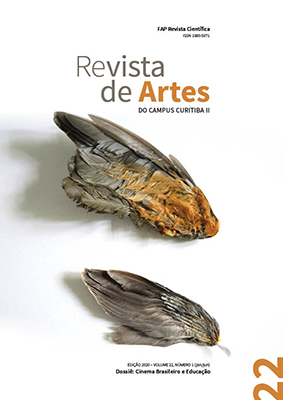DOS ARES DE MILONGA À DÉLIBÁB: UMA ANÁLISE A PARTIR DA PERSPECTIVA DA EXPERIÊNCIA
DOI:
https://doi.org/10.33871/19805071.2020.22.1.3184Abstract
O objetivo deste trabalho é realizar uma reflexão acerca das diferenças sonoras nas milongas do artista gaúcho Vitor Ramil. Tomo como corpus o disco Ramilonga (1997) e Délibáb (2010), por se tratarem de discos só de milongas. O referencial teórico é a perspectiva da experiência de Tuan (2013). Nossa análise sugere que a experiência de Ramil (apresentada no documentário Délibáb-Documental) é fundamental para promover uma alteração sonora em suas milongas. Enquanto o disco de 1997 cria espaços orientais e místicos sobre o pampa gaúcho, a experiência pelos arrebaldes de Buenos Aires e pelas planícies em que viveu Vargas cobram um passo à tradição.
Downloads
References
AUTOR, 2017
BORGES, Jorge Luís. El otro, el mismo / Para las seis cuerdas / Elogio de la sombra. 1ª ed. Buenos Aires: Debolsillo, 2012.
FISCHER, L. A. Nesta rua passa o universo. In: RAMIL, Vitor. Vitor Ramil - Songbook. Caxias do Sul: Belas-Letras, 2013.
LOPES NETO, João Simões. Contos gauchescos. Porto Alegre: Novo século, 2000.
RAMIL, Vitor. A estética do frio: conferência de Genebra. Porto Alegre: Satolep, 2004.
RAMIL, Vitor. Vitor Ramil - Songbook. Caxias do Sul: Belas-Letras, 2013.
RUBIRA, Luís. Vitor Ramil - Nascer leva tempo (identidade, autossuperação e criação de Estrela, estrela a Longes). Porto Alegre: Pubblicato Editora, 2017.
TATIT, Luís. Estimar canções: estimativas íntimas na formação do sentido. São Paulo: Ateliê Editorial, 2015.
TUAN, Yi-Fu. Espaço e lugar: a perspectiva da experiência. Tradução: Lívia de Oliveira. Londrina: Eduel, 2013.
Discografia
RAMIL, Vitor. Ramilonga - A estética do frio. Satolep, 1997.
RAMIL, Vitor. Délibáb. Satolep, 2010.
Filmografia
DÉLIBíB DOCUMENTAL. Direção: César Custódio. Satolep, 2010. 1 DVD (70 minutos).
Downloads
Published
How to Cite
Issue
Section
License
The authors retain the copyright, when licensing their production in Revista Científica/FAP, which is licensed under a Creative Commons license. When submitting the article, and upon acceptance, the author assigns his copyright for publication in that journal.
Readers can download, print and use the articles published in the journal, as long as there is always an explicit mention of the author (s) and the Revista Científica/FAP, no changes to the original work are allowed. When submitting an article to Revista Científica/FAP and after its being accepted for publication, the authors allow, without remuneration, to pass the following rights to the Journal: the first edition rights and the authorization for the editorial team to transfer, according to their judgment, this article and its metadata to indexing and reference services.


